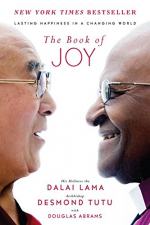
|
| Name: _________________________ | Period: ___________________ |
This test consists of 5 multiple choice questions, 5 short answer questions, and 10 short essay questions.
Multiple Choice Questions
1. What color is the Dalai Lama's traditional robe?
(a) Green.
(b) Black.
(c) Maroon.
(d) Navy blue.
2. What is the Tibetan word for envy?
(a) Suka.
(b) Bonfen.
(c) Trakdok.
(d) Mudita.
3. What is the Buddhist phrase for taking pleasure in others' good fortune?
(a) Ramala.
(b) Setu.
(c) Mafala.
(d) Mudita.
4. Which young leader in South Africa was assassinated, deeply hurting Archbishop Tutu?
(a) Marlon Jamison.
(b) Katri Ballard.
(c) Chris Hani.
(d) Marion Barry.
5. What is the name of the famous prison that held many freedom fighters in South Africa during apartheid?
(a) Robben Island.
(b) Mohijo Prison.
(c) Van Dieman's Land.
(d) Alcatraz.
Short Answer Questions
1. What neuropsychiatrist's work does Abrams quote in Part II about anger?
2. What is mental immunity, according to the Dalai Lama?
3. Archbishop Tutu says he feels that each individual is which of the following "in the making"?
4. What does the Dalai Lama think of when he considers the act of eating?
5. Who does Tutu bring with him to visit the Dalai Lama?
Short Essay Questions
1. In the Introduction, what analogy does Abrams make about the book itself?
2. In Part I, what kind of relationship does the Dalai Lama tell Archbishop Tutu he considers their relationship to be a bit like?
3. In Part I, what frightening personal story does Abrams share about his own family?
4. In Part II, what is the meaning of Archbishop Tutu's phrase "you are a masterpiece in the making" (92)?
5. In Part II, what does Abrams learn about Archbishop's Tutu methods of calming himself when the two are stuck in bad traffic?
6. In Part II, what does the Dalai Lama advise for people who are grieving lost loved ones?
7. In Part II, what is the meaning of the word "dukkha?"
8. In Part II, what does the Dalai Lama say that stress and anxiety in modern life are often caused by?
9. In Part I, what does Archbishop Tutu say ultimately leads to people's greatest experiences of joy?
10. In Part II, what do both the Dalai Lama and Archbishop Tutu advise as a way of handling one's worries?
|
This section contains 764 words (approx. 3 pages at 300 words per page) |

|




